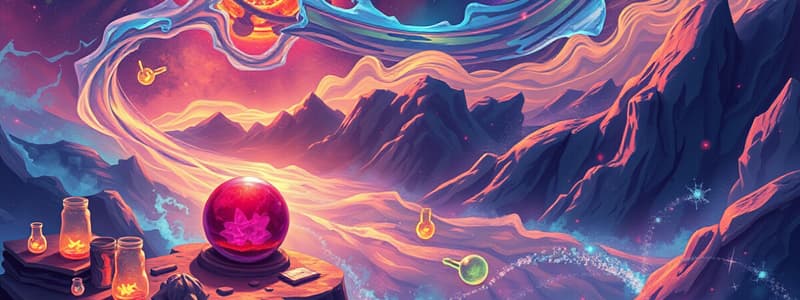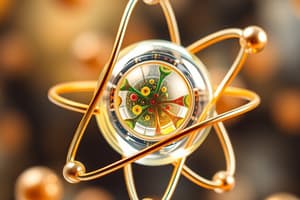Podcast
Questions and Answers
What is matter?
What is matter?
- A bond created when electrons are shared
- Anything that has mass and takes up space (correct)
- The smallest unit of matter
- The center of an atom
What is an atom?
What is an atom?
The smallest unit of matter composed of protons, neutrons, and electrons.
What is the nucleus of an atom?
What is the nucleus of an atom?
The center of an atom composed of protons and neutrons.
What is a proton?
What is a proton?
What is an electron?
What is an electron?
What is a neutron?
What is a neutron?
What is an element?
What is an element?
What does atomic number represent?
What does atomic number represent?
What is mass number?
What is mass number?
What is a compound?
What is a compound?
What is an ionic bond?
What is an ionic bond?
What is a covalent bond?
What is a covalent bond?
What is a polar covalent bond?
What is a polar covalent bond?
What is the octet rule?
What is the octet rule?
What is valence?
What is valence?
What is an ion?
What is an ion?
What is an isotope?
What is an isotope?
What is a cation?
What is a cation?
What is an anion?
What is an anion?
What is a hydrogen bond?
What is a hydrogen bond?
What are van der Waals forces?
What are van der Waals forces?
What is a solute?
What is a solute?
What is a solvent?
What is a solvent?
What is specific heat?
What is specific heat?
What is an acid?
What is an acid?
What is a base?
What is a base?
What are buffers?
What are buffers?
What are reactants?
What are reactants?
What is a catabolic reaction?
What is a catabolic reaction?
What is an anabolic reaction?
What is an anabolic reaction?
What is an endergonic reaction?
What is an endergonic reaction?
What is an exergonic reaction?
What is an exergonic reaction?
What is electronegativity?
What is electronegativity?
Flashcards are hidden until you start studying
Study Notes
Basic Chemistry Concepts
- Matter: Anything with mass that occupies space.
- Atom: The smallest matter unit, made of protons, neutrons, and electrons.
- Nucleus: Central part of an atom, containing protons and neutrons.
- Proton: A positively charged subatomic particle found in the nucleus.
- Electron: A negatively charged subatomic particle that orbits the nucleus.
- Neutron: A neutral subatomic particle, also located in the nucleus.
Elements and Compounds
- Element: A pure substance consisting of only one type of atom, characterized by its atomic number.
- Atomic Number: Number of protons in an atom, unique to each element.
- Mass Number: Total mass of an atom, determined by the sum of protons and neutrons.
- Compound: A substance formed from two or more atoms chemically bonded together.
Chemical Bonds
- Ionic Bond: Formed when one atom donates electrons to another, resulting in oppositely charged ions.
- Covalent Bond: Created by the sharing of electron pairs between atoms.
- Polar Covalent Bond: Uneven sharing of electrons producing charged poles in the bond.
Atomic Structure and Stability
- Octet Rule: States that atoms are most stable with eight electrons in their valences.
- Valence: The outermost energy level of an atom that participates in bonding.
- Ion: A charged species formed by gaining or losing electrons.
- Isotope: Variants of an atom with the same number of protons but different neutrons.
Ionic Species
- Cation: A positively charged ion formed by losing electrons.
- Anion: A negatively charged ion formed by gaining electrons.
Intermolecular Forces
- Hydrogen Bond: Attraction involving hydrogen and an electronegative atom in a polar bond.
- van der Waals Forces: Weak attractions occurring between molecules due to temporary dipoles.
Solutions and Reactions
- Solute: The substance that is dissolved in a solution.
- Solvent: The substance that dissolves the solute, making a solution.
- Specific Heat: Indicates how well a substance can absorb heat energy.
Acids and Bases
- Acid: Releases hydrogen ions in solution, decreasing pH.
- Base: Accepts hydrogen ions or releases hydroxide ions, increasing pH.
- Buffers: Substances that help maintain pH by converting strong acids or bases into weaker ones.
Types of Chemical Reactions
- Reactants: Materials that initiate a chemical reaction.
- Catabolic Reaction: Breaks down molecules, releasing energy by breaking chemical bonds.
- Anabolic Reaction: Builds molecules, consuming energy to form chemical bonds.
- Endergonic Reaction: Absorbs energy from its surroundings.
- Exergonic Reaction: Releases energy during the reaction.
Electronegativity
- Electronegativity: An atom's ability to attract and hold onto electrons, affecting bond formation and molecule stability.
Studying That Suits You
Use AI to generate personalized quizzes and flashcards to suit your learning preferences.




